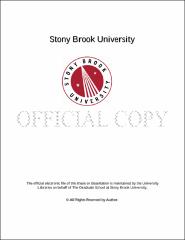| dc.identifier.uri | http://hdl.handle.net/11401/76344 | |
| dc.description.sponsorship | This work is sponsored by the Stony Brook University Graduate School in compliance with the requirements for completion of degree. | en_US |
| dc.format | Monograph | |
| dc.format.medium | Electronic Resource | en_US |
| dc.language.iso | en_US | |
| dc.publisher | The Graduate School, Stony Brook University: Stony Brook, NY. | |
| dc.type | Thesis | |
| dcterms.abstract | The effects of supercritical carbon dioxide (scCO2) as an effective plasticization agent on the crystallization kinetics and crystal morphology of ultrathin polycaprolactone (PCL) films (less than 100nm in thickness) were studied by using various techniques including optical microscopy, atomic force microscopy, and x-ray scattering experiments. As a result, it is found that the PCL chains form " flat-on" lamellae, where the lamellar layers run parallel to the substrate surface, irrespective of the CO2 process conditions and the film thickness. It was also found that the unique scCO2 conditions near the critical point (critical temperature (Tc) =31.3°C and critical pressure (PC) =7.38MPa) result in the significant enhancement of the crystal size compared to those under the other scCO2 process conditions or conventional high-temperature annealing process. Furthermore, it was found that scCO2 induces the secondary heterogeneous nucleation of the excess melt on the film surface during the isothermal re-crystallization process. | |
| dcterms.abstract | The effects of supercritical carbon dioxide (scCO2) as an effective plasticization agent on the crystallization kinetics and crystal morphology of ultrathin polycaprolactone (PCL) films (less than 100nm in thickness) were studied by using various techniques including optical microscopy, atomic force microscopy, and x-ray scattering experiments. As a result, it is found that the PCL chains form " flat-on" lamellae, where the lamellar layers run parallel to the substrate surface, irrespective of the CO2 process conditions and the film thickness. It was also found that the unique scCO2 conditions near the critical point (critical temperature (Tc) =31.3°C and critical pressure (PC) =7.38MPa) result in the significant enhancement of the crystal size compared to those under the other scCO2 process conditions or conventional high-temperature annealing process. Furthermore, it was found that scCO2 induces the secondary heterogeneous nucleation of the excess melt on the film surface during the isothermal re-crystallization process. | |
| dcterms.available | 2017-09-20T16:50:04Z | |
| dcterms.contributor | Venkatesh, T | en_US |
| dcterms.contributor | Koga, Tadanori | en_US |
| dcterms.contributor | Gersappe, Dilip. | en_US |
| dcterms.creator | Sen, Mani Kuntal | |
| dcterms.dateAccepted | 2017-09-20T16:50:04Z | |
| dcterms.dateSubmitted | 2017-09-20T16:50:04Z | |
| dcterms.description | Department of Materials Science and Engineering. | en_US |
| dcterms.extent | 40 pg. | en_US |
| dcterms.format | Application/PDF | en_US |
| dcterms.format | Monograph | |
| dcterms.identifier | http://hdl.handle.net/11401/76344 | |
| dcterms.issued | 2012-12-01 | |
| dcterms.language | en_US | |
| dcterms.provenance | Made available in DSpace on 2017-09-20T16:50:04Z (GMT). No. of bitstreams: 1
Sen_grad.sunysb_0771M_11097.pdf: 2095996 bytes, checksum: 9d7e8ceb2fb28b47673b18ec20e7756c (MD5)
Previous issue date: 1 | en |
| dcterms.publisher | The Graduate School, Stony Brook University: Stony Brook, NY. | |
| dcterms.subject | crystallization, lamellar orientation, overgrowth morphology, Polycaprolactone, semi-crystalline polymer, supercritical carbon dioxide | |
| dcterms.subject | Materials Science | |
| dcterms.title | Crystallization kinetics and crystal morphology of ultrathin polycaprolactone films directed by supercritical carbon dioxide. | |
| dcterms.type | Thesis | |

